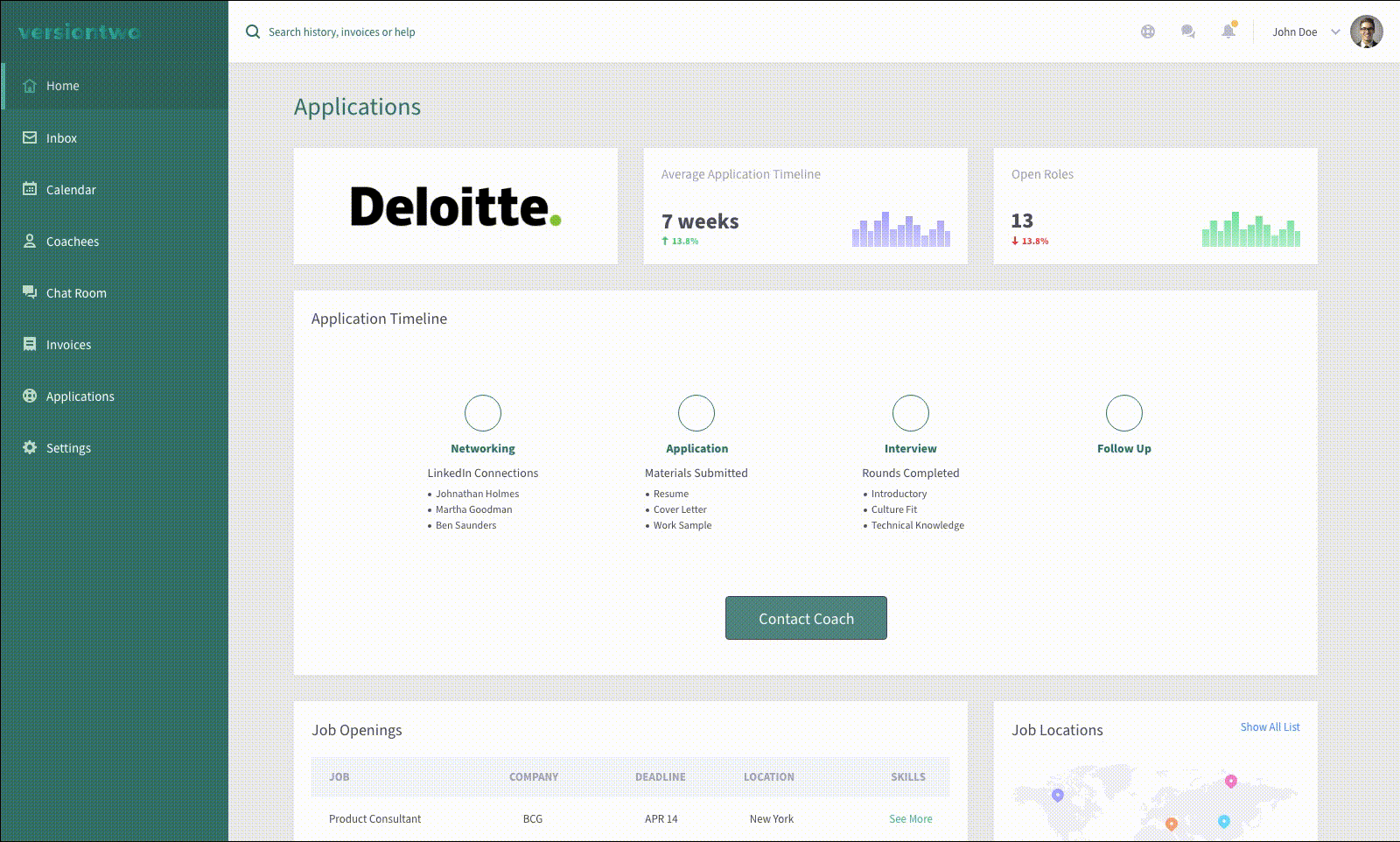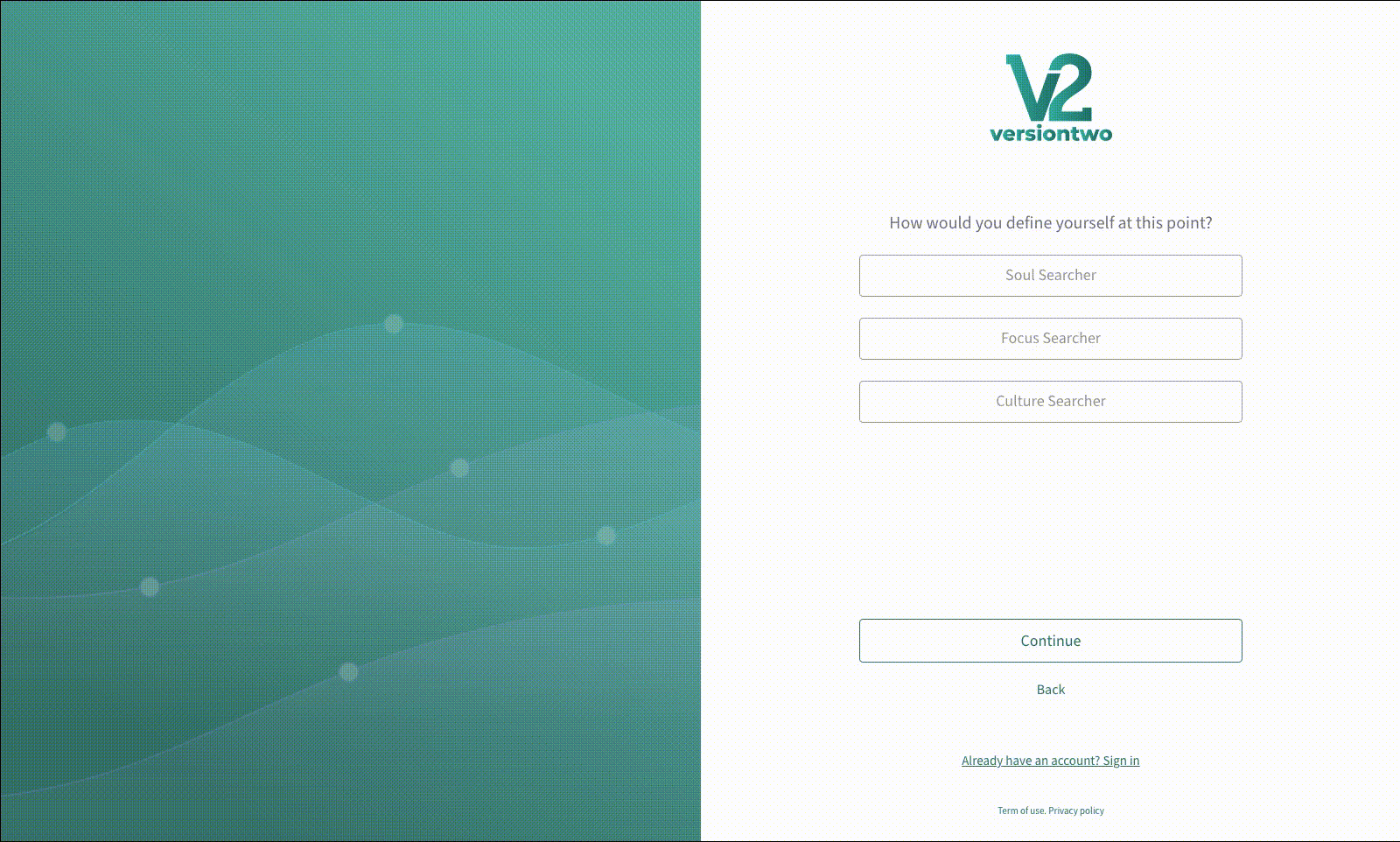

Shaping Career Shifts
Empowering Pivoting Professionals to
Shape Their Careers
Version Two, a fledgling startup based out of The Garage at Northwestern University, sought to provide affordable and personalized career coaching to recent graduates looking to start or transition careers. Because the startup offered customized service to clients by manually managing communication, tasks assignment, and review through an array of tools, my team was called to consult for the startup to suggest a more optimized and singular tool to provide career coaching services.
Through this project, my team continuously iterated in gathering insights from user research, translating insights into defined points of interaction, conducting user tests to evaluate design characteristics, and designing interfaces for a digital solution.
Interaction Design Studio, Northwestern University, Winter 2019
Problem
Young professionals unhappy in their current careers face difficulty in finding the optimal next professional experience due to a variety of barriers including lack of framed experience, ineffective applications, and overall frustration with the complex process.
Goal
How might we help clients first discover careers that best mirror their passions and skillsets, then help differentiate them from the pool of applications to obtain their dream job?
Design
By digitizing the Version Two coaching experience through a single management portal, we can streamline and optimize the curriculum offerings and communication lines between the clients and personal coach.
An Integrated Digital Portal to Optimize Career Shift Journey
Through a digital portal accessible by career coaches and their respective clients, Version Two can optimize its services by collecting and documenting resource materials in a singular, manageable location and offer key features.
Customized Career Guidance
Goal Progress Monitoring
Social Motivation & Accountability
A digital portal solves for:
-
Disorganization of communication and materials between coach and client
-
Accessibility of coaching resources by clients
-
Scalability and growth of Version Two's service


RESEARCH SYNTHESIS
Through multiple rounds of user interviews and testing, I actively sought to synthesize my observations into key insights and takeaways by leveraging frameworks such as journey maps, empathy maps, experience flows, and semantic profiles. These frameworks helped guide formation of design characteristics for a solution.

USER RESEARCH
I honed my research skills by identifying and utilizing a wide range of methods to thoroughly evaluate and validate design hypotheses about young professionals seeking a career pivot:
-
User Interviews
-
Explorative Studies
-
Card Sorting
-
A/B Tests
-
Focus Groups
DESIGN SPRINTS
My team utilized a structured process for answering critical business questions through rapidly designing, iterating, prototyping, and testing ideas with users. We iteratively planned, executed, and learned from each sprint by focusing on a very specific design characteristic to test, validate, and refine.
SELF-DIRECTION
Consulting for a startup with an early-stage offering and very little direction to work off, I was presented with a high level of ambiguity. Despite this, I focused on the core constraints and goals to guide the project. As the project progressed, I gained more confidence in driving design decisions by quickly executing and learning.

Research Methods
By conducting a wide range of iterative research through multiple design sprints, my team was able to ensure the optimization and streamlining off Version Two's services to its clients.

Mapping the
Job Search Journey
Through interviews with young professionals, both current and potential clients of Version Two, we mapped the series of steps that occur in the job search process and identified key themes that arose across various stages.

Key Pain Points
Maintaining motivation is key in the job search process - without which, people are more likely to discontinue applying for new roles or to settle for a role that is not the right fit for them.
Emotional and mental barriers to networking
Reaching out to people in hopes of connecting over a potential career opportunity is a daunting task to many job searchers.
Networking is the best way to find a lot of jobs but I never know how to reach out to someone or what to say.

Isolation through job search process
Searching for and applying to new jobs is a very vulnerable process and can be stressful for people to go through alone.
It feels hard to talk about how my job search is going when there's so much uncertainty in the process.
Ambiguity after submitting applications
The waiting stage posed the greatest challenge to people as the lack of action at this time leads to frustration and loss of motivation.
I hate the period after I apply when I'm pretty much waiting for what feels like forever to know what's next.
User Personas

Career Coach
Subject matter experts in the career defining space who want to offer tools and resources to people seeking career starts or changes.
High Level Goals
Customize service for clients with different needs and at different stages of career search. Manage multiple clients at once.
Strengths
Related Experience
Defining Career Goal
Application Materials
Networking Ability

Soul Searcher
People who are not content where they are but don't know where to go, what to do, or anything about how to find their dream job
High Level Goals
Find out what their personal goals are. Discover what type of job or industry they would be happy in with their skillset and experiences.
Strengths
Related Experience
Defined Career Goal
Application Materials
Networking Ability

Focus Searcher
People who may know where they want to go regarding job or industry, but have no idea how to get there or overcome their obstacles to get there
High Level Goals
Learn how to be considered for their dream job. Prepare materials necessary for strong applications. Find specific companies to apply to.
Strengths
Related Experience
Defined Career Goal
Application Materials
Networking Ability

Culture Searcher
People who know what job they want and how to get there, but have trouble finding a company that is the best fit for them
High Level Goals
Define in detail all the opportunities relevant to their skillset, experiences, and interests. Find the best balance in compensation and company.
Strengths
Related Experience
Defined Career Goal
Application Materials
Networking Ability
Design Sprints
Define User Need
Source Users
Create Prototypes
Test with Users
Synthesize Findings
Iterate & Finalize
My team utilized a structured process to answer critical business questions through rapidly designing, prototyping, testing, and iterating users. Each sprint was planned and executed with the goal of validating a design argument about users.
Sprint 0
Identifying User
Motivations
Goal: We first focused on uncovering the high level behaviors, goals, and pain points users faced in seeking new jobs.
Risk: By not fully understanding the problem space, we would not be able to design for the true needs of our users.
Finding: We identified distinct user personas, each with motivations and obstacles in seeking a career start or change.
Sprint 1
Maintaining Progress
Goal: How might we empower users to maintain self-motivation through feeling lost in the ambiguity of the waiting period?
Risk: Users can feel defeated during the waiting stage and through rejections, which can hinder their overall progress.
Finding: Users sought a continuous level of engagement to maintain their motivation in working towards finding their ideal role.
Sprint 2
Customized Guidance
Goal: How might we provide users with guidance to achieve their goal in finding ideal job?
Risk: Too much or too little direction could be ineffective in guiding users to their higher goal.
Finding: Users wanted to be held accountable to complete the tasks necessary to accomplish the goals they set for themselves.
Sprint 3
Leveraging Networking
Goal: How might we lower the mental and emotional barrier users face in networking to access unposted jobs?
Risk: Avoiding networking prevents users from accessing the ~81% of jobs that are unposted and available through a contact.
Finding: Users were more comfortable with the prospect of networking if they were better prepared with language and context.
Sprint 4
Peer-to-Peer Accountability
Goal: How might we leverage social engagement to motivate users to be accountable for their assigned tasks?
Risk: Being isolated in the job search process can hinder progress towards attaining ideal job.
Finding: Users who participated in group sessions put more effort into completing their assigned tasks than users who were isolated.
Key Features Tested
Social Groups
Users found social engagement with other job seekers to be motivating factors to their own process.
Users found social engagement with other job seekers to be motivating factors to their own process.
Writing Auto Bot
Users desired guidance with editing application materials but wanted to keep level of autonomy in the process.
Push Notifications
Users were wary of the emotional consequences of receiving constant notifications about their progress.

Coach Chat Box
Users favored an internal chat tool on the Version Two portal to communicate with coaches about tasks in-real-time.

Explicit Direction
Users reacted negatively with being given too specific of instructions on how to prepare application materials.
Application Timeline
Users reacted positively to a visualization of their progress and goals to meet through the job search process.
Suggested Guidance
Users were open to receiving guidance from coaches across career goal defining, resume writing, and network initiating.
Next Steps
Users were open to receiving actionable next steps with applications to confront the ambiguity of waiting.
Coach Check-ins
Users reacted positively to check-ins with coaches to reflect on their progress and receive iterative guidance.
Networking Template
Users found it very helpful to have a template to draft networking messages to but wanted to maintain their voice.

Self-Guided Direction
Users were most proud of being able to set their own pace regarding their career search journey.
Contact Trading
Users did not find trading relevant contacts as valuable as learning how to approach them for career opportunities.

be your best







